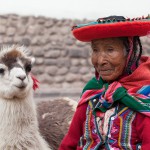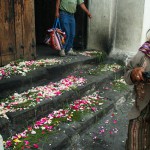Before the commercialisation of the mountain, the king of the mountain, Reinhold Messner, once called Fritz Wiessner, was the most pivotal mountaineer of the 20th century. Messner was the first to climb all 14 of the 8,000-meter high peaks, as well as the first to make a solo ascent of Everest without supplemental oxygen. Messener’s comment about Wiessner was because Messner himself didn’t make it to the summit of the K2 (the second highest mountain in the world), not because of the difficulty, but because his Sherpa didn’t want to provoke the night’s spirit on the mountain and wished to turn back.
That is an incredible attitude to have on the mountain, which is not always seen nowadays. All over the world carriers, cooks and guides are being exploited, often because some individuals wish to realise their dreams.
The Sherpa people, who moved from the Tibetan plateau 300 years ago to Nepal, are part of an ethnic group of 80,000 people. They have been used as labour on mountaineering expeditions since the very beginning. They may be strong, fast and cheap to hire, but they are not invincible.
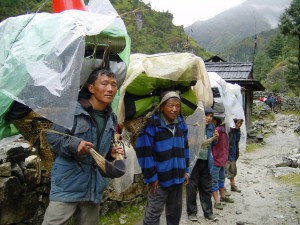 In 1922, during the first serious attempt of Everest, 7 Sherpas died in an avalanche. In April of 2014, the worst tragedy in the history of mountaineering happened resulting in the death of 16 Sherpas in the Kumbu Passage. In total, 174 climbing Sherpas have died while working in the mountains in Nepal—15 in the past decade, on Everest alone. Their workplace mortality rate is 1,2 percent, making it the only service industry in the world where workers are so frequently killed and maimed for the benefit of paying clients.
In 1922, during the first serious attempt of Everest, 7 Sherpas died in an avalanche. In April of 2014, the worst tragedy in the history of mountaineering happened resulting in the death of 16 Sherpas in the Kumbu Passage. In total, 174 climbing Sherpas have died while working in the mountains in Nepal—15 in the past decade, on Everest alone. Their workplace mortality rate is 1,2 percent, making it the only service industry in the world where workers are so frequently killed and maimed for the benefit of paying clients.
It wasn’t always so popular to climb Everest and other high peaks. Nowadays, given all the technology available, the bottled oxygen that you can use to make it to the top and the fact that you, even if you are not in shape to carry your stuff, can just pay others to do it for you, has turned mountain climbing into a gigantic industry. In 1963, 6 people reached the top of Everest while in 2012, 500 people did it. Sometimes, it is even so crowded at the top that it is hard to find a place at some of the camps.
Statistics show that around 90 percent of the climbers on Everest are guided clients without formal mountaineering training, who completely rely on Sherpa guides, novices who end up endangering their own lives as well as the Sherpas’. Those clients pay between US$30 000 to $120,000.
For the Sherpas, it is a lucrative but deadly job. They do it because of the salary they earn (typically $5,000/season – eight times Nepal’s average annual income per capita. “If somebody in America climbs Everest 19 times, he’d be all over Budweiser commercials, Sherpas don’t get the same recognition” Norbu Tenzing Norgay once said on the subject.
Sherpas working above Base Camp need at least $4,600 in death coverage and $575 in medical, while low-altitude porters must be insured at $3,500. Each expedition must also cover its Sherpas with, collectively, at least $4,000 in rescue insurance. Though, High-altitude helicopter rescues cost $15,000 each…
Without the efforts of the Sherpas on Everest, no commercial expedition would make it to the summit.
The Himalayas is a mountain range in South Asia. It’s the home of the 14 highest summits in the world (each of them higher than 8,000 meters). Five of them are located in Pakistan and eight are in Nepal.
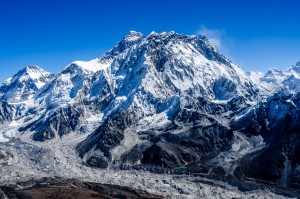 Sylvain is a Canadian climber who went to Pakistan with an international expedition three years ago in order to reach G2 (8,035meters). According to him, it is necessary for them to hire carriers, at least up to base camp. The 47 days of expedition could have been spent on just transporting material up to base camp if it wasn’t for the Baltis, the carriers in Pakistan. Due to ethical considerations, Baltis were only hired up to base camp, and no high-altitude carrier was used during the expedition Sylvain took part in.
Sylvain is a Canadian climber who went to Pakistan with an international expedition three years ago in order to reach G2 (8,035meters). According to him, it is necessary for them to hire carriers, at least up to base camp. The 47 days of expedition could have been spent on just transporting material up to base camp if it wasn’t for the Baltis, the carriers in Pakistan. Due to ethical considerations, Baltis were only hired up to base camp, and no high-altitude carrier was used during the expedition Sylvain took part in.
There is a tradition that when you hire guides, as a passionate and experienced climber, you share a respect that is mutual. For example, Sylvain’s birthday took place during the expedition, and at base camp, the cooks made him a huge chocolate cake. He split the cake into even pieces to divide between the members of the expedition and the cooks. The cooks were really touched by the gesture.
Unfortunately, there are not only alpinists on the mountain, there are also tourists and that’s why the ethics of interaction have changed so much. Tourists are bringing so much money to the villages in the area and are now an important economic resource . Carriers have to map the trails, prepare the equipment and carry it all the way to the next stop. They often wear sandals, go without climbing glasses, and carry heavy back packs (as can seen in the picture, even chairs are brought to the camp in order to maximise the comfort of the clients).
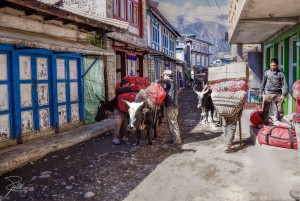 Sylvain, the climber, said the Sherpas and Baltis conditions are sad, they are underpaid for the hard work they are doing, but it has improved over the years. For example, one of the members of the expedition drove a van from Spain to Pakistan and gave it to one of the local communities to help them start their own association. The association aims to encourage expeditions to hire local Baltis instead of bringing Sherpas or guides from Nepal.
Sylvain, the climber, said the Sherpas and Baltis conditions are sad, they are underpaid for the hard work they are doing, but it has improved over the years. For example, one of the members of the expedition drove a van from Spain to Pakistan and gave it to one of the local communities to help them start their own association. The association aims to encourage expeditions to hire local Baltis instead of bringing Sherpas or guides from Nepal.
An expedition the year before had given their Baltis all of their solar glasses against reverberation, but none of them had them the next year, all the glasses had been sold in order to bring home more money for their families. The same thing happens with climbing boots.
If you are a client, the minimum you can do is to respect the one you hire, to respect the carrier (Sherpas, Baltis or others) and all the other members of the team. Mountaineering isn’t just about making it to the summit, it is about the journey, and the footprint you leave on the mountain. You may be the one climbing today but others are going to climb tomorrow too. Respect can go along with enjoyment.
By Aurore Menard
Image credit:
Picture 1: jarikir, licensed under CC BY-NC-ND 2.0
Picture 2: Frank Kehren, licensed under CC BY-NC-ND 2.0
Picture 3: Fryderyk Supinski, licensed under CC BY-NC 2.0

